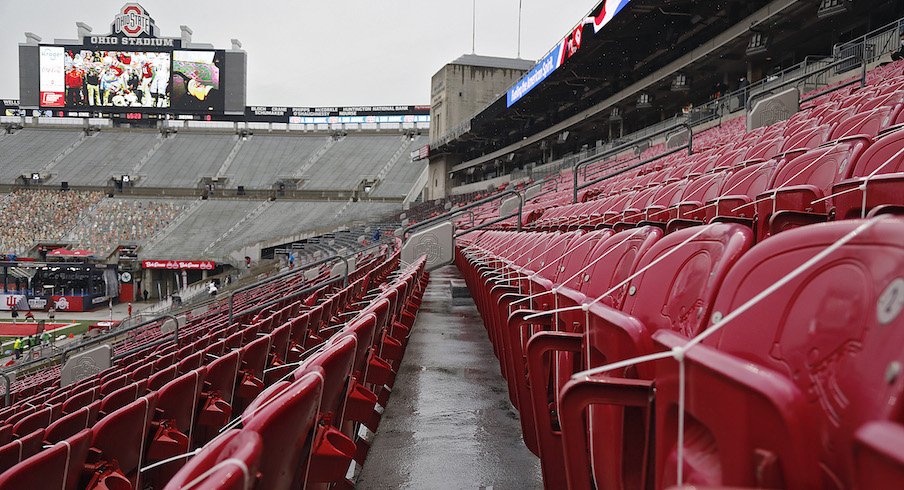Ohio State’s athletic department is facing a steep deficit for the 2021 fiscal year, but it’s not as bad as it could have been.
Back in September, Ohio State projected a $107 million deficit for its athletic department for the 2021 fiscal year. That projection, however, did not include media rights revenue, and since the Buckeyes were ultimately able to play a fall football season, Ohio State is now projecting a deficit of between $60 million and $70 million with hopes of still lowering that further, athletic director Gene Smith said Wednesday.
“We’re moving in a positive direction,” Smith said. “Obviously having football, as you all know, helped mitigate the $107 million projection that we had. So we’re somewhere between $60-70 million that we’re projecting. We have to wait for basketball to get done, see if the actual NCAA Tournament goes off and all those types of things, but my goal hopefully is to get that south of $60 million by year’s end.”
With the Big Ten’s decision not to allow fans at any sporting events this year due to COVID-19, a substantial deficit for the Ohio State athletic department was inevitable. Ticket sales made up nearly $66 million of Ohio State’s revenues for the 2020 fiscal year (which included the 2019 football season), and other streams of revenue have also been impacted by the year-long pandemic.
As a result, the Ohio State athletic department will have to take a loan from the university to pay off that debt. Eventually, though, all of that money will be paid back to the university with interest, and that’s important to Ohio State, which takes pride in having a self-sustaining athletic department.
“We will obviously have a deficit by year end that we’ll have to work out the accounting part with our CFO, but it’ll be a 5-7 year type of loan that we will have to pay. And we will still, in my view, be self-supporting, because it will be an interest-bearing loan,” Smith said. “I’m not sure what the rate is ultimately going to be, but that’s something that we’ll have to work out.”
The deficit puts Ohio State – which typically makes more money than it spends, including a profit of $18,662,174 for the 2020 fiscal year – in an unusual position. The athletic department already took measures to reduce its expenses for this year, including layoffs, furloughs and pay cuts as well as cuts from operating budgets. Certainly, Ohio State’s athletic department will have to continue making careful budgetary considerations for the next several years as it pays off its debt to the university.
That said, Smith does not want budget cuts to come at the expense of Ohio State’s athletes or of the Buckeyes’ ability to compete at the highest level across their array of 36 varsity sports. So while Ohio State has made and will continue to evaluate where it can make cuts and has to make cuts, don’t expect the deficit to stop Ohio State from making sure coaches like Ryan Day and Chris Holtmann are well-compensated.
“There’s things that we have to do that are uncontrollable, and there’s things that we have to do in order to make sure we maintain our level of excellence. We have to make those investments,” Smith said. “Talent acquisition, talent development and talent retention is significant. I’m going to say that again. Talent acquisition, talent development and talent retention is critical. We’re wildly successful because of the people skills that we’re blessed to have in our family. And so, at the end of the day, I don’t want to use examples but you guys can, there’s certain people that we gotta make sure that we’re spending the necessary investment in them, to help professionally develop them, to help them get better.”
Smith expects the athletic department’s personnel costs to continue to increase – Smith said they typically “go up by 3-5% depending on the year” – while athlete scholarship costs also increase as the university’s tuition and fees increase. Smith also said he anticipates hiring someone or contracting a third party to assist Ohio State athletes with name, image and likeness benefits once those go into effect, which will be another added expenditure.
That means the athletic department will need to continue to increase its revenues going forward to remain profitable, which is one reason why Ohio State announced Thursday that it will switch to a new football season ticket model that Smith believes will eventually increase annual contributions to the Buckeye Club, the athletic department’s fundraising arm, from its current intake of slightly less than $14 million to upwards of $25 million.
Ohio State’s opportunities to increase revenue in some other areas, like corporate sponsorships, are limited for the time being.
“We’ve maximized all of our third-party relationships,” Smith said. “Our Nike deal at $252 million is still No. 1 in the country, that’s in play until 2032. Our Learfield/IMG deal is in play until 2032. Our concessions deal which has different escalators based upon volume is done. Our Gatorade deal is done. Our Coke deal is done. All those deals you guys have read about over the years, they’re done, they’re at the top of the pyramid.
“We will, at some point in the conference, probably have a new television deal that we’ll negotiate. But we can’t budget to that, because we don’t know what that’s going to be. I’m hopeful there’s an upside, but I can’t be clear, I don’t know that.”
All of that said, Smith remains optimistic about the financial stability and future of the Ohio State athletic department, believing OSU has a sound budget plan that will enable its revenues to outpace its expenses once again when the pandemic subsides and fans are back inside Ohio Stadium and the Schottenstein Center.
“I feel really good about where we are,” Smith said. “And I feel good about our future as well.”


